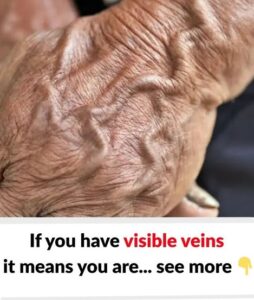Why Veins Become More Noticeable with Age

As the years go by, the body shifts in subtle ways that can sometimes catch us off guard. One such change is the increased visibility of veins on the hands, arms, legs, and chest. For many, these suddenly prominent veins can be worrying — but in most cases, they’re simply a natural part of growing older rather than a sign of illness.
Thinner Skin and Less Cushioning
A key reason veins stand out more as we age is the gradual thinning of the skin. Over time, the body produces less collagen and elastin — the proteins that keep skin firm, elastic, and youthful-looking. With less support from these proteins, skin becomes more fragile and translucent, revealing what lies beneath.
In addition, the layer of fat beneath the skin (which normally cushions and hides veins) slowly diminishes with age. As this protective layer shrinks, veins that were once hidden become visible, particularly in thin-skinned areas like the hands and forearms.
Changes Within the Veins
It’s not only the skin that changes — veins themselves transform with age. Their walls and valves may weaken, which reduces their efficiency at pushing blood back to the heart. When blood flow slows or pools, veins can swell or twist, creating varicose veins. These are especially common in the legs, where gravity and long periods of standing or sitting put extra strain on circulation.
Circulation and Lifestyle Factors
Aging also slows circulation in general. Hormonal shifts, reduced physical activity, and weaker calf muscles (which normally act as pumps for blood in the legs) all contribute to this. As blood flow becomes less efficient, veins can appear darker, larger, and more noticeable.
Genetics play a strong role, too. If your family members have visible veins, chances are higher that you’ll experience them as well. Lifestyle choices can speed up the process — smoking and frequent sun exposure both break down collagen and damage blood vessels, making veins show through earlier and more prominently.
Interestingly, even young, active people can have visible veins. Athletes, especially those who lift weights or do endurance training, often develop “vascularity” because low body fat and strong muscles push veins closer to the skin. During workouts, blood flow increases, temporarily enlarging veins and making them stand out more.
When to See a Doctor
In most cases, visible veins are harmless. However, you should seek medical advice if the change is sudden and accompanied by pain, swelling, heat, redness, or changes in skin color. These symptoms could indicate blood clots, infection, or other circulatory problems that need medical attention.
Options for Those Who Feel Self-Conscious
If the appearance of veins is bothersome, cosmetic treatments are available. Procedures like sclerotherapy (injections that collapse veins), laser therapy, or vein removal surgery can reduce their visibility. These are usually chosen for aesthetic reasons, not medical ones.
A Natural Sign of Time
Visible veins are a normal part of aging — a reflection of skin changes, circulation shifts, and life lived. Rather than seeing them as flaws, many view them as natural reminders of resilience and experience. And for those who prefer a smoother look, modern treatments offer safe ways to minimize their appearance.